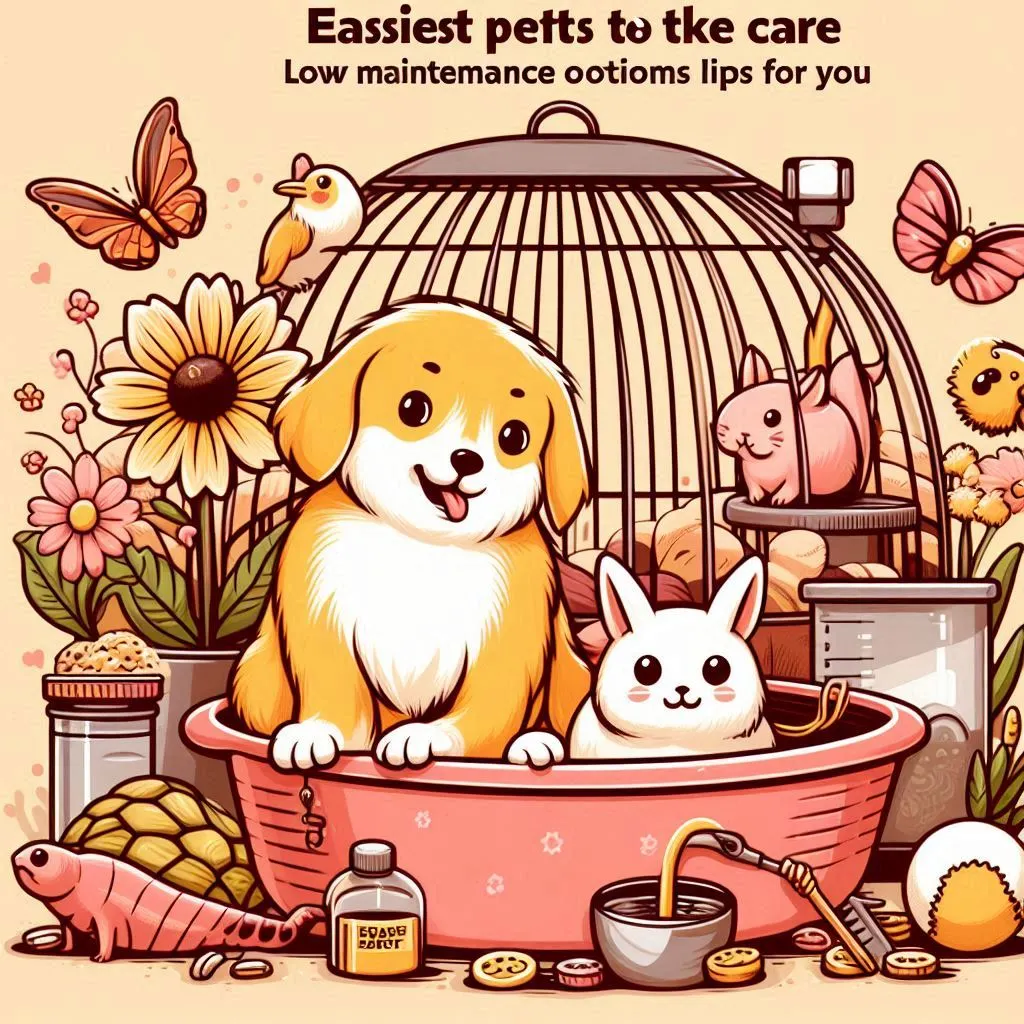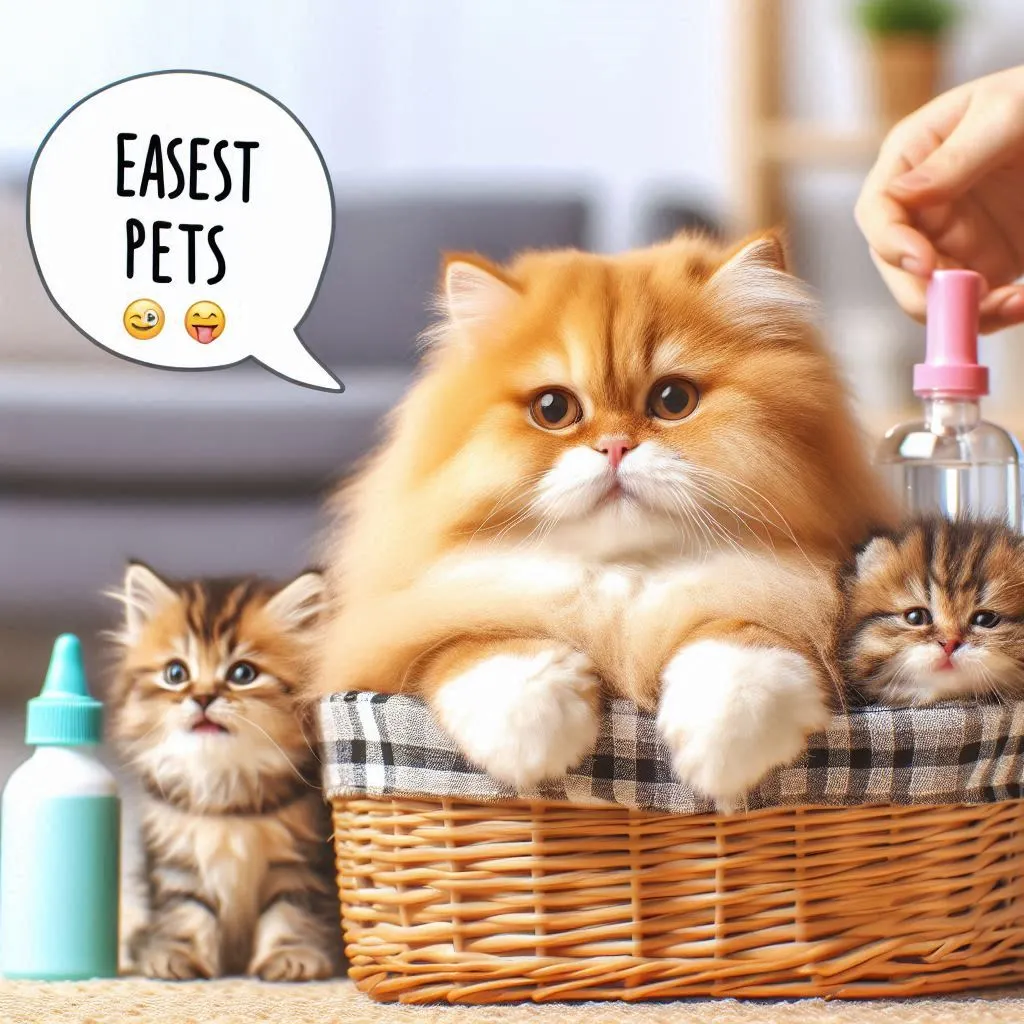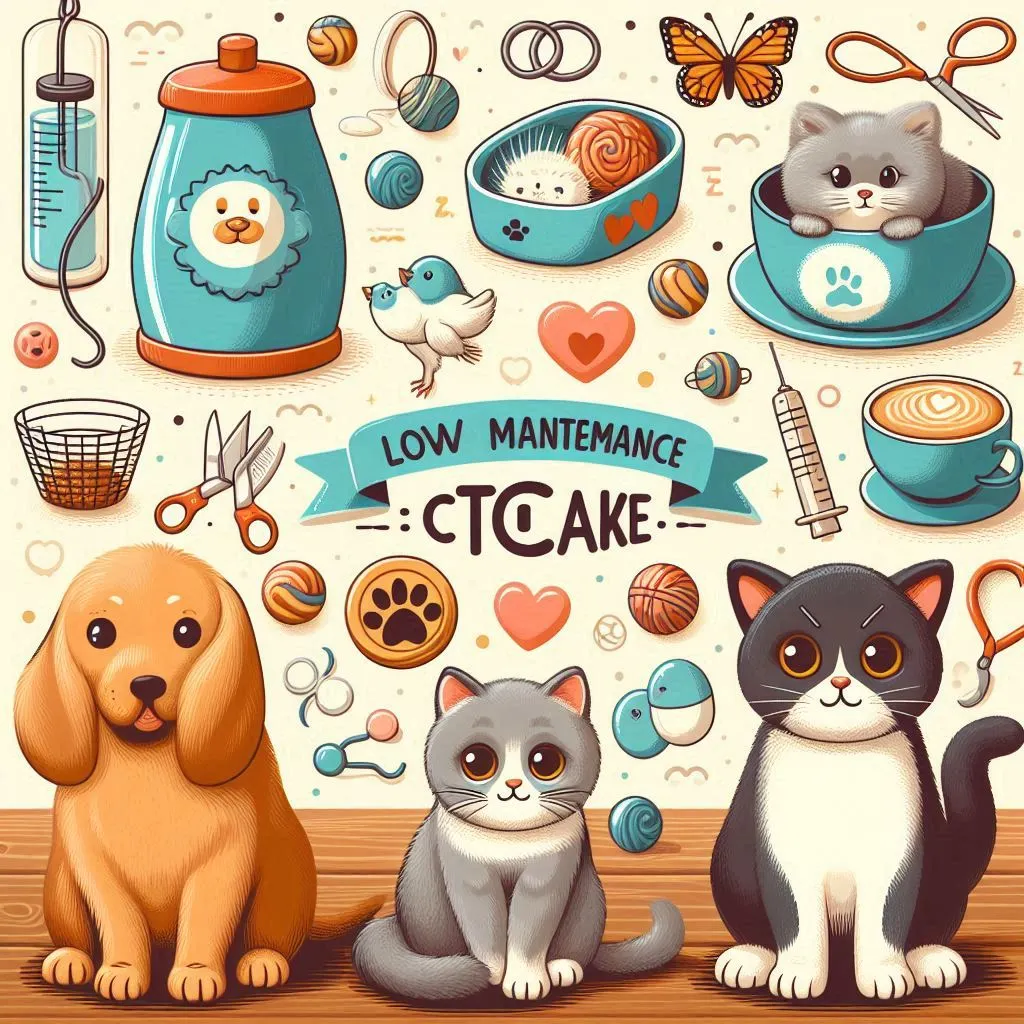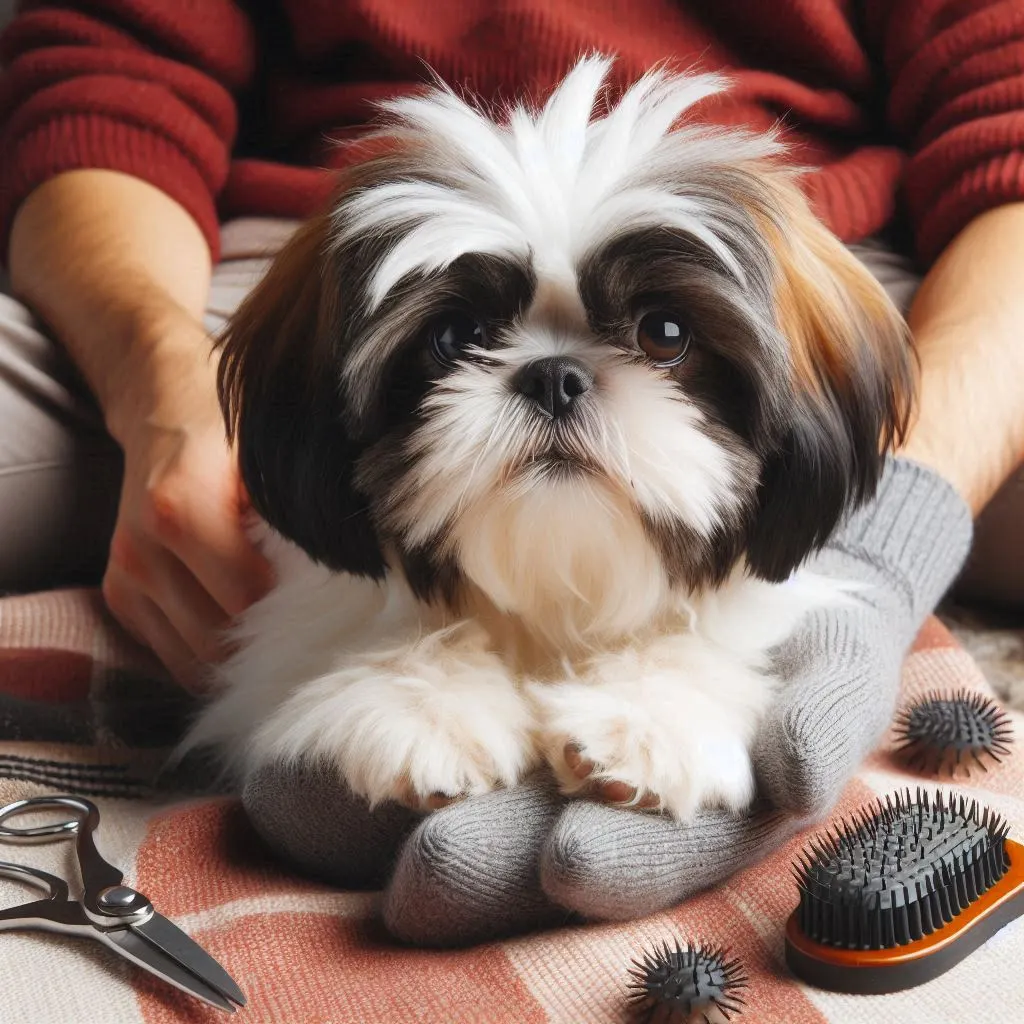Top 10 Easiest Pets to Take Care Of Low Maintenance Options for You
If you’re new to pet ownership or looking for a pet that requires little time and effort, you’ve come to the right place. This article will explore the 10 easiest pets to take care of, perfect for beginners or those with busy lifestyles who want a pet that fits their schedule. These low-maintenance pets offer companionship without the demanding needs of more high-maintenance animals like cats and dogs.
What are the best low-maintenance pets for beginners?
Finding a pet that’s easy to care for is crucial for those new to pet ownership. Some of the best low-maintenance pets include hamsters, guinea pigs, and hermit crabs. These little guys don’t require much attention and are relatively easy to maintain, making them great pets for beginners.
Why are hamsters considered easy pets?
Hamsters are often regarded as one of the easiest pets to care for, especially for those new to pet ownership. These small, nocturnal rodents are popular pets for several reasons. First, they don’t require a lot of space, making them ideal for people living in apartments or small homes. A simple cage with some bedding, a wheel for exercise, and a few toys is all they need. Hamsters also have relatively low maintenance when it comes to feeding – they typically eat a commercial hamster food supplemented with fresh fruits and vegetables.
Additionally, hamsters are generally clean animals and groom themselves, reducing the need for regular bathing. Their nocturnal nature means they’re most active at night, which can be perfect for people busy during the day. While they may not be as affectionate as other pets, hamsters can still provide entertainment and companionship, making them a great choice for those looking for an easy-to-care-for pet.
Are guinea pigs good for first-time pet owners?
Guinea pigs are excellent choices for first-time pet owners, especially those looking for a low-maintenance companion. These docile and friendly rodents are known for their gentle nature, making them great pets for children and adults. Guinea pigs are relatively easy to care for, requiring a spacious cage, fresh food and water daily, and regular living space cleaning. Unlike other small pets, guinea pigs are social creatures and often enjoy human interaction, which can be rewarding for new pet owners.
They have a longer lifespan than hamsters, typically living 4-8 years, allowing for a more extended period of companionship. Guinea pigs are also diurnal, meaning they’re active during the day, which can be more convenient for those who want to interact with their pets during waking hours. While they may require slightly more attention than some other low-maintenance pets, their friendly demeanour and relatively simple care requirements make them an excellent choice for those new to pet ownership.

How do hermit crabs rank as low maintenance companions?
Hermit crabs are often overlooked but rank highly as low-maintenance companions for those seeking an easy-to-care-for pet. These fascinating creatures are relatively simple to maintain, making them ideal for beginners or those with limited time for pet care. Hermit crabs require a terrarium-style habitat with a substrate they can burrow in, hiding spots and climbing opportunities. Their diet consists of commercial hermit crab food supplemented with fresh fruits and vegetables, and they need access to both fresh and saltwater.
One of the most appealing aspects of hermit crabs as pets is their low demand for human interaction. While they can be interesting to observe, they don’t require the same attention as many other pets. Hermit crabs are also quiet and odourless when properly cared for, making them excellent pets for those living in apartments or shared spaces who want a low-maintenance pet. Their unique appearance and behaviour can be a great conversation starter, and watching them change shells as they grow can be an educational experience. While they may not be cuddly or affectionate like other pets, hermit crabs offer a low-maintenance pet option that can still provide enjoyment and companionship.
Which reptiles are easiest to care for as pets?
Reptiles can make great low-maintenance pets for those interested in exotic animals, especially those who want a pet that doesn’t demand constant attention. Among the easiest reptiles to care for are leopard geckos, corn snakes, and certain species of turtles. These reptiles generally require specific habitats but are relatively easy to maintain once set up properly.
Is a leopard gecko a good choice for novice pet owners?
Leopard geckos are excellent for novice pet owners looking for a low-maintenance reptile companion. These charming lizards are known for their docile nature and relatively simple care requirements, making them one of the easiest pets to take care of in the reptile world. Leopard geckos don’t require large enclosures, which makes them suitable for those with limited space. A 20-30 gallon tank is typically sufficient for an adult gecko. Unlike many other reptiles, leopard geckos don’t need special UVB lighting; they’re nocturnal creatures.
Their diet mainly consists of insects like crickets and mealworms, readily available at most pet stores. Leopard geckos are also known for being handleable and can even become accustomed to gentle human interaction over time. They have a relatively long lifespan of 10-20 years, providing long-term companionship for those committed to their care, making them some of the best pets. While they may not be cuddly like some mammals, their unique appearance and calm demeanour make them fascinating pets to observe and interact with. A leopard gecko is an excellent choice for those new to reptile ownership or looking for a low-maintenance pet that’s out of the ordinary.

How easy is it to take care of a corn snake?
Corn snakes are widely regarded as one of the easiest snakes to care for, making them an excellent choice for those new to snake ownership or looking for a low-maintenance reptile pet. These non-venomous snakes are known for their docile nature and relatively small size, typically growing to about 3-5 feet long. Corn snakes are relatively easy to house, requiring a secure enclosure with proper temperature gradients and hiding spots.
They don’t need extremely large terrariums, with a 20-30 gallon tank usually sufficing for an adult, which makes them easy to take care of. Feeding corn snakes is straightforward, as they primarily eat pre-killed mice, which can be purchased frozen and thawed before feeding. This eliminates the need for live prey, which can concern some pet owners.
Corn snakes are also known for their low odour and minimal waste production, making cage cleaning a less frequent task compared to many other pets. While they may not be as interactive as other pets, corn snakes can become accustomed to gentle handling and be fascinating to observe. Their beautiful colouration, patterns, and interesting behaviours make them attractive pets for those interested in reptiles. With a lifespan of 15-20 years in captivity, corn snakes can provide long-term companionship for committed owners. Overall, their ease of care, manageable size, and interesting nature make corn snakes an excellent choice for those seeking a low-maintenance pet.
Are turtles low-maintenance pets?
Turtles, particularly species like the painted turtle, can be considered low-maintenance pets, but it’s important to note that their care requirements can be more complex than some other animals on this list. Turtles are often regarded as easy pets to care for due to their calm nature and long lifespan, which can extend several decades, making them one of the best pets for beginners. However, they do require specific housing and care to thrive. Turtles need a proper aquarium setup with water and land areas and appropriate filtration systems to maintain water quality. They also require specific lighting to ensure adequate shell and bone health, making them low-maintenance pets for busy lives.
Regarding feeding, turtles are omnivores and need a varied diet of commercial turtle food, vegetables, and occasional protein sources. While daily interaction isn’t necessary, regular tank cleaning and water changes are crucial for their health, as saltwater fish require specific conditions to thrive. One advantage of turtles as pets is their independence – they don’t need constant attention or affection as some other pets might. They can be fascinating to observe and can recognize their owners over time.
For those willing to invest in the initial setup and commit to proper care, turtles can be rewarding, low-maintenance companions. However, potential owners should be aware of the long-term commitment involved, as many turtle species can live for several decades with proper care.
What are the easiest aquatic pets to maintain?
Aquatic pets can be surprisingly low-maintenance and easy to care for. Some of the easiest aquatic pets include sea monkeys (brine shrimp), male betta fish, and certain species of freshwater fish. These marine creatures often require minimal space and can thrive in small tanks, making them ideal for those with limited room.

How simple is it to care for sea monkeys or brine shrimp?
Sea monkeys, also known as brine shrimp, are arguably one of the easiest pets to take care of, making them an excellent choice for beginners or those seeking an extremely low-maintenance pet. If you’re a 90s kid, you likely remember the popularity of these tiny aquatic creatures. Sea monkeys require minimal setup and care, making them ideal for people who don’t want to invest much time or money in pet ownership.
To start a sea monkey colony, all you need is a small tank or the kit that often comes with them, purified water, and the packet of eggs and nutrients provided, making them one of the easiest to take care of beginner pets. Once set up, sea monkeys don’t require much ongoing care, making them ideal for those who want a pet without much commitment.
They need to be fed small amounts of their special food every few days, and their water should be aerated occasionally by stirring or using a pipette to introduce air bubbles. Unlike many other aquatic pets, sea monkeys don’t require filtration systems or regular water changes if maintained properly. They’re also incredibly hardy and can survive in various temperatures, though they thrive best in warmer conditions.
While sea monkeys may not provide the same level of interaction as some other pets, they can be fascinating to observe as they grow and reproduce. Their low maintenance requirements and the educational aspect of watching their life cycle make them popular choices for children’s first pets or for adults looking for an easy-to-care-for aquatic companion.
Are male betta fish suitable for beginners?
Male betta fish, also known as Siamese fighting fish, are suitable for beginners and rank high on the list of easiest pets to care for. These vibrant and beautiful fish are popular among novice fish keepers due to their simple care requirements and stunning appearance. Male bettas are known for their long, flowing fins and bright colours, making them visually appealing pets.
One of the main advantages of keeping a male betta is that they can thrive in small tanks, making them ideal for those with limited space. A 5-gallon tank is generally sufficient for a single male betta, though larger tanks are always beneficial. Unlike many other fish species, bettas have a labyrinth organ that allows them to breathe air from the surface, meaning they can survive in environments with lower oxygen levels.
This characteristic makes them more forgiving of less-than-perfect water conditions, although regular water changes are still necessary for their health. Feeding bettas is straightforward, as they primarily eat commercial betta pellets or flakes, with occasional treats like freeze-dried bloodworms. It’s important to note that male bettas are territorial and should be kept alone, as they may fight with other bettas or similar-looking fish. While they don’t require companionship from other fish, bettas can recognize their owners and even learn simple tricks, providing a level of interaction unusual for fish. Their relatively easy care requirements, beauty, and interesting behaviours make male betta fish an excellent choice for those new to fish keeping or looking for a low-maintenance aquatic pet.
What makes freshwater fish low-maintenance pets?
Freshwater fish are often considered low-maintenance pets, making them an excellent choice for beginners or those looking for easy-to-care-for companions. Several factors contribute to their status as low-maintenance pets. Firstly, many freshwater fish species are hardy and adaptable, able to thrive in various water conditions. This resilience makes them more forgiving of minor fluctuations in water quality, which can occur in home aquariums. Popular low-maintenance freshwater fish, such as guppies, tetras, and danios, are often recommended for beginner pet owners. These fish typically don’t require large tanks, with some species doing well in tanks as small as 10 gallons, making them suitable for those with limited space.
Feeding freshwater fish is generally straightforward, with most species thriving on a commercial flake or pellet food diet. Many freshwater fish are social creatures that do well in groups, creating a vibrant and active aquarium environment without needing individual attention. Unlike some pets that require daily interaction or exercise, fish can be left alone for short periods without issue, as long as they have an automatic feeder, which is a key benefit of owning a pet fish. While regular maintenance, such as water changes and filter cleaning, is necessary, these tasks are typically less time-consuming than the care requirements of many other pets.
Which small mammals are considered low-maintenance pets?
Several small mammals are known for being low-maintenance pets. Rats, hamsters, and guinea pigs are often considered among the easiest pets to take care of in the mammal category. These animals typically require less space and attention than larger pets, making them ideal for those with limited time or living space.
How easy is it to care for pet rats?
Pet rats are often overlooked but are actually one of the easiest pets to take care of among small mammals. These intelligent and social creatures make great low-maintenance pets for several reasons. Firstly, rats are relatively small and don’t require a lot of space, making them suitable for apartments or small homes. A large cage with multiple levels, toys, and hiding spots is sufficient for a pair of rats. Unlike some other rodents, rats are highly social animals and do best when kept in pairs or small groups of the same sex, providing companionship for each other.
This social nature also extends to their human caregivers, as rats can form strong bonds with their owners and enjoy interaction. Feeding rats is straightforward, with a diet consisting primarily of commercial rat food supplemented with fresh fruits and vegetables. Rats are also known for their cleanliness, regularly grooming themselves and their cage mates. While their cage needs regular cleaning, this task is generally less demanding than for some other pets. One of the most appealing aspects of rats as pets is their intelligence, which can make them fascinating companions for those who enjoy owning a pet. They can learn tricks, respond to their names, and even solve simple puzzles, providing mental stimulation for the rat and the owner.
Rats are also known for being affectionate and can enjoy cuddling with their owners. Some might consider Their shorter lifespan of 2-3 years a disadvantage, but it can also make them a good choice for those not ready for a long-term pet commitment. Their intelligence, affection, and relatively simple care requirements make rats an excellent choice for those seeking a low-maintenance mammalian pet.
Are hamsters the easiest rodents to keep as pets?
Hamsters are often considered one of the easiest rodents to keep as pets, making them a popular choice for beginners and those looking for low-maintenance companions in a busy life. These small, nocturnal creatures require less space and care than many other pets. A simple cage with a wheel for exercise, some toys, and hiding spots is usually sufficient for a hamster’s needs, providing a small but enriching environment. One of the main advantages of keeping hamsters is their independent nature. Unlike pets requiring constant attention, hamsters are content with minimal daily interaction, making them ideal for busy individuals or families.
Feeding hamsters is straightforward, with a diet primarily consisting of commercial hamster food supplemented with small amounts of fresh fruits and vegetables. Hamsters are also naturally clean animals and spend significant time grooming themselves, reducing their owners’ need for baths or extensive grooming, a hallmark of easy-to-take care pets. Their nocturnal habits mean they’re most active during the evening and night, which can be ideal for people who are away during the day. While hamsters may not be as social or interactive as other pets, they can still provide entertainment with their cute behaviours.
They can become accustomed to gentle handling over time. It’s worth noting that while hamsters are generally easy to care for, they do have a relatively short lifespan of 2-3 years, which can be seen as either a drawback or an advantage, depending on the owner’s perspective. Overall, their small size, simple care requirements, and independent nature make hamsters one of the easiest rodents to keep as pets, especially for those new to pet ownership or looking for a low-maintenance animal companion.
What makes guinea pigs good low-maintenance pets?
Guinea pigs are often considered excellent low-maintenance pets, particularly for those new to pet ownership or looking for an easy-to-care-for animal. These gentle rodents have several characteristics that make them ideal for beginners. Firstly, guinea pigs are known for their docile and friendly nature. They rarely bite and can become quite tame with regular, gentle handling, making them great pets for children and adults.
Unlike some other small pets, guinea pigs are diurnal, meaning they’re active during the day, which aligns well with human schedules and allows for more interaction. In terms of housing, guinea pigs require a relatively spacious cage but don’t need an elaborate setup. A simple cage with bedding, hiding spots, and some toys is sufficient. They don’t need wheels or complex exercise equipment like other rodents, making them great beginner pets. Feeding guinea pigs is straightforward, with a diet consisting mainly of hay, commercial guinea pig pellets, and fresh vegetables. They also don’t require frequent bathing, as they generally keep themselves clean. One of the appealing aspects of guinea pigs as low-maintenance pets is their social nature.
They enjoy companionship and do well when kept in pairs or small groups, providing entertainment for each other and reducing the demand on their owners for constant interaction. Guinea pigs are also relatively quiet pets, making only soft vocalizations, which is ideal for apartment living. While they require daily care regarding feeding and occasional cage cleaning, the time commitment is generally less than for many other pets. With a 4-8 years lifespan, guinea pigs offer longer-term companionship compared to some other small pets, without the decades-long commitment of larger animals. Their gentle temperament, simple care requirements, and social nature make guinea pigs excellent low-maintenance pets for many owners.
What are the best low-maintenance pets for those with limited space?
Several low-maintenance pet options are available for those living in small apartments or homes with limited space. Hermit crabs, canaries, and leopard geckos are all excellent choices for compact living situations. These pets don’t require large enclosures or extensive setups, making them ideal for those with space constraints.
How do hermit crabs fare as easy-to-care-for pets in small living spaces?
Hermit crabs are excellent choices as easy-to-care-for pets, especially for those living in small spaces. These fascinating creatures are among the easiest pets to take care of and are well-suited to compact living environments. Hermit crabs don’t require large enclosures; a 10-20 gallon tank is often sufficient for a small group, making them ideal for apartments or rooms with limited space. Their habitat needs are relatively simple:
- A substrate they can burrow in.
- Some climbing structures.
- Shells for them to change into as they grow.
One of the main advantages of hermit crabs as low-maintenance pets is their minimal care requirements. They need fresh food and water daily, but the quantities are small, and their diet can consist of commercial hermit crab food supplemented with small amounts of fruits and vegetables. Hermit crabs are also quiet pets, which significantly benefit those living in apartments or shared spaces.
They don’t produce odours when properly cared for, further adding to their suitability for small living areas. While hermit crabs may not be as interactive as some other pets, they can be fascinating to observe as they explore their environment, change shells, and interact with each other. They don’t require daily handling or extensive interaction, making them ideal for busy individuals or those who prefer a more hands-off pet. It’s worth noting that hermit crabs are social creatures and do best when kept in small groups, which can provide entertainment for both the crabs and their owners.
Their long lifespan, potentially up to 30 years with proper care, means they can be long-term companions for those willing to commit to their care. Hermit crabs’ small size, simple care requirements, and suitability for compact living spaces make them excellent low-maintenance pets for those with limited room.
Are canaries suitable for low-maintenance pets in apartments?
Canaries are indeed suitable for low-maintenance pets for apartments, making them an excellent choice for those seeking an easy-to-care-for pet in a limited space. These small, colourful birds are known for their beautiful singing, which can add a pleasant ambience to any home without being overly loud or disruptive to neighbours. Canaries only require a small amount of space, with a cage measuring about 20 inches in length, width, and height sufficient for a single bird.
This compact housing requirement makes them ideal for apartment living or for those with limited room for pet accommodations. Regarding care, canaries are relatively low-maintenance compared to many other pets. Their diet primarily consists of a high-quality commercial canary seed mix supplemented with fresh vegetables and occasional treats. Fresh water should be provided daily; their food and water containers need regular cleaning. While daily interaction isn’t necessary, canaries appreciate a consistent routine and can become accustomed to their owner’s presence.
Unlike other pets, canaries don’t require extensive training or exercise outside their cage, although providing toys and perches is important for their well-being. One of the appealing aspects of canaries as pets is their independent nature. They don’t demand constant attention or handling, making them suitable for individuals with busy lifestyles. However, they still provide companionship through their presence and melodic singing, which can be comforting in a busy life.
Canaries are also relatively clean birds and don’t produce strong odours when properly cared for, another advantage for apartment living. With a 5-10-year lifespan, canaries offer a medium-term commitment, providing years of companionship without the decades-long responsibility of some larger pets. Their beautiful appearance, soothing songs, and relatively simple care requirements make canaries an excellent choice for those seeking a low-maintenance pet suitable for apartment living.
Can leopard geckos thrive in compact habitats?
Leopard geckos are excellent candidates for thriving in compact habitats, making them one of the easiest pets to care for, especially those with limited space. These small, docile reptiles are well-suited to life in terrariums, with a 20-30-gallon tank being sufficient for an adult gecko. This modest space requirement makes them ideal pets for apartments or small homes where space is at a premium. Leopard geckos are naturally adapted to arid environments, simplifying their habitat needs.
Unlike many other reptiles, they don’t require complex lighting setups or high humidity levels, further contributing to their status as low-maintenance pets. A simple setup with a heat gradient, hiding spots, and a substrate they can easily walk on is all needed to keep a leopard gecko comfortable. Feeding leopard geckos is relatively straightforward, with a diet primarily consisting of insects such as crickets and mealworms, which are readily available at most pet stores. They don’t require daily feeding, with adult geckos typically eating every other day or even less frequently. Leopard geckos are also known for their cleanliness and low odour, making them excellent pets for small living spaces.
They tend to use one area of their enclosure as a bathroom, which makes cleaning quick and easy. Another advantage of leopard geckos in compact habitats is their nocturnal nature. This means they’re most active during the evening and night, aligning well with the schedules of many working individuals. While they may not be as interactive as other pets, leopard geckos can become accustomed to gentle handling and recognize their owners over time. Their unique appearance and interesting behaviours make them fascinating, even in a small habitat. With proper care, leopard geckos can live for 10-20 years, offering long-term companionship without requiring much space.
Their ability to thrive in compact habitats and their relatively simple care requirements make leopard geckos an excellent choice for those seeking a low-maintenance pet in a small living space.
How do different low-maintenance pets compare in terms of human interaction?
When it comes to human interaction, low-maintenance pets can vary greatly. Some, like guinea pigs and rats, are quite social and enjoy human company, proving they can make great family pets. Others, such as hermit crabs or certain fish species, require minimal interaction. Understanding the level of interaction each pet requires or enjoys is crucial in choosing the right low-maintenance pet for your lifestyle and preferences, especially for a 90s kid likely to want an easy pet.
Which easy-to-care-for pets are most affectionate?
Among the easy-to-care-for pets, several are particularly affectionate, balancing low maintenance and the ability to form strong bonds with their owners. Despite their sometimes negative reputation, rats are among the most affectionate low-maintenance pets, making them excellent choices for beginner pet owners. These intelligent rodents are known for their social nature and can form strong attachments to their owners. They enjoy being handled, can learn tricks, and often seek out human interaction.
Rats are capable of recognizing their owners and may even come when called. Guinea pigs are another affectionate option among the easiest pets to care for. These gentle creatures are known for their docile nature and can become very tame with regular, gentle handling. They often enjoy sitting on their owner’s lap and may “purr” when content. While not typically considered affectionate, some species of small birds, like budgies or cockatiels, can also form strong bonds with their owners. These birds can be interactive, learning to mimic sounds or words, and may enjoy sitting on their owner’s shoulder or hand.
Among reptiles, bearded dragons are known for being one of the more affectionate species. While not cuddly in the traditional sense, they often enjoy being handled and may even seek their owner’s attention. It’s important to note that individual personalities can vary greatly, even within species known for being affectionate. Proper socialization and regular, gentle interaction from a young age can help foster a pet’s affectionate nature. While these pets may not show affection in the same way as cats or dogs, their unique forms of bonding can be equally rewarding for owners seeking a low-maintenance pet with the capacity for meaningful interaction.
Are there any low-maintenance pets that enjoy cuddling?
While the term “cuddling” might bring to mind more traditional pets like cats and dogs, some low-maintenance pets enjoy close physical contact with their owners. Guinea pigs, for instance, are among the easiest pets to take care of and are known for their cuddly nature. These gentle rodents often enjoy sitting on their owner’s lap or chest, especially when they feel safe and comfortable. With regular handling, many guinea pigs grow to appreciate and seek out this close contact.
Rats, another low-maintenance pet option, are affectionate and can enjoy cuddling with their owners. They may climb onto shoulders, nestle in pockets, or contentedly sit in a person’s hands or lap. Some rat owners even report their pets enjoying being cradled like a baby. While not typically thought of as cuddly, some reptiles, like bearded dragons, can enjoy a form of cuddling and might even like to be held occasionally. They may contentedly rest on their owner’s chest or shoulder, enjoying the warmth. However, it’s important to note that their version of cuddling is more about seeking warmth and security than affection in the mammalian sense.
Among small birds, cockatiels are known for being one of the more cuddly species. While they may not cuddle in the same way as furry pets, many cockatiels enjoy nestling against their owner’s neck or sitting on their shoulder for extended periods. It’s crucial to remember that individual personalities can vary greatly, even within species known for being cuddly. Some animals may warm up to physical contact, while others may naturally seek it out. Patience, gentle handling, and respect for the animal’s boundaries are key in fostering a relationship where a pet feels comfortable with close physical contact.
While these low-maintenance pets may not cuddle exactly the same way as larger, more traditional pets, they can still provide a satisfying level of physical interaction for owners seeking a cuddly companion without the higher demands of cat or dog ownership.
What are the best low-maintenance pets for those seeking minimal interaction?
For individuals seeking low-maintenance pets requiring minimal interaction, several excellent options are available. These pets are ideal for those with busy lifestyles, limited time, or preferring more independent animal companions. Among the easiest pets to care for with minimal interaction requirements are fish, particularly species like bettas or goldfish.
These aquatic pets don’t require handling and are content with basic care such as regular feeding and tank maintenance. Observing fish can be relaxing and enjoyable without the need for direct interaction. Hermit crabs are another great option for those seeking minimal interaction. These fascinating creatures are largely self-sufficient and don’t require daily handling. They can be interesting to observe as they explore their habitat and change shells, but they don’t seek human interaction like many other pets do.
Leopard geckos are an excellent choice among reptiles for those wanting a low-interaction pet. These nocturnal lizards are content in their enclosures and don’t require daily handling. They can be fascinating to watch, especially during their more active evening hours, but are perfectly happy without frequent human contact.
FAQ for Easiest Pets to Take Care Of: Low-Maintenance
Q: What are some of the easiest pets for beginners to take care of?
A: Some of the easiest pets for beginners include hamsters, guinea pigs, leopard geckos, corn snakes, hermit crabs, and sea monkeys. These low-maintenance pets don’t require as much attention as cats or dogs, making them ideal for those new to pet ownership or with busy lifestyles.
Q: Are hamsters good low-maintenance pets?
A: Yes, hamsters are great low-maintenance pets. They’re small, easy to care for, and don’t need much space. Hamsters require a cage, food, water, and some toys for enrichment. They’re nocturnal, perfect for people busy during the day.
Q: How easy is taking care of a snake as a pet?
A: Snakes, particularly corn snakes, are relatively easy to care for. They don’t require daily interaction and can be fed once a week. Snakes need a properly sized terrarium with controlled temperature and humidity. While they’re not cuddly, they can be fascinating pets for those interested in reptiles.
Q: What makes sea monkeys one of the easiest pets to care for?
A: Sea monkeys, a type of brine shrimp, are incredibly low-maintenance pets. They require a small tank with treated water and occasional feeding. Sea monkeys don’t need much attention and can be a fun, educational pet for children or adults who want a simple aquatic pet.
Q: Are turtles considered low-maintenance pets?
A: Turtles, like painted turtles, can be relatively low-maintenance pets. They need a proper habitat with clean water, a basking area, and appropriate lighting. While they require regular feeding and tank cleaning, they don’t need daily interaction like other pets. However, it’s important to note that turtles have a long lifespan, so they’re a long-term commitment.
Q: How easy is it to care for a leopard gecko?
Leopard geckos are one of the easiest reptiles to care for, making them great beginner pets for those new to reptile ownership. They don’t require a large habitat and are docile creatures. They need a warm environment, regular feeding, and occasional misting. Leopard geckos are also known for being handleable, making them great for those who want a reptile pet they can interact with.
Q: Are hermit crabs good low-maintenance pets?
A: Hermit crabs can be excellent low-maintenance pets. They need a terrarium with proper substrate, humidity, and hiding spots. Hermit crabs are relatively easy to feed and don’t require daily handling. Watching them change shells and interact with their environment can be fascinating.
Q: What makes guinea pigs one of the 10 easiest pets to care for?
A: Guinea pigs are considered one of the easiest pets to care for because they’re gentle, social, and relatively low-maintenance. They need a spacious cage, regular feeding, and daily interaction. Guinea pigs are great for families looking for a more interactive pet than other small animals but still easier to care for than cats or dogs.















Post Comment